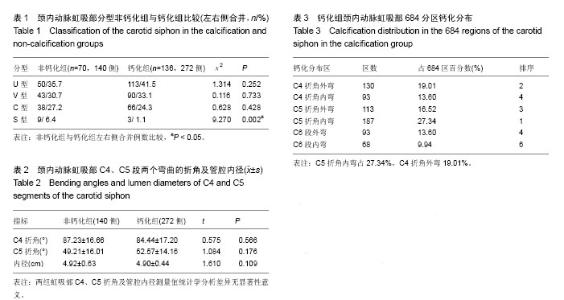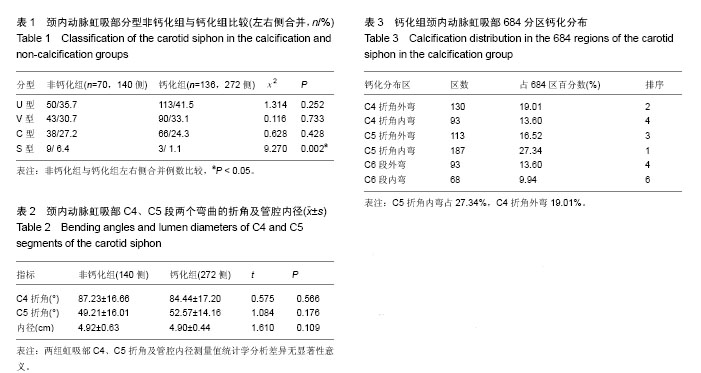| [1] 张弛,韩景芸,蒲放,等.颈内动脉虹吸部血流的数值计算和模型实验[J]. 医用生物力学,2013,28(1):56-62.
[2] 陈丽君,荆晶,林长华,等. 基于CT数据颈内动脉虹吸部有限元建模[J]. 临床医学工程,2012,19(1):1-2.
[3] 吕绍茂,钟华,陈丽君,等.构建颈内动脉瘤双向流固耦合模型的血流模拟[J].中国组织工程研究,2014,18(2):218-224.
[4] Valen-Sendstad K, Piccinelli M, Steinman DA.High-resolution computational fluid dynamics detects flow instabilities in the carotid siphon: implications for aneurysm initiation and rupture? J Biomech. 2014, 22;47(12):3210-3216.
[5] Lauric A, Hippelheuser J, Safain MG, et al. Curvature effect on hemodynamic conditions at the inner bend of the carotid siphon and its relation to aneurysm formation. J Biomech. 2014, 47(12):3018-3027.
[6] Bouthillier A,van Loveren HR,Keller JT,et al. Segments of the internal carotid artery: a new classification. Neurosurgery. 1996;38(3):425-32; discussion 432-433.
[7] 韩淘.国人脑血管X 线解剖学研究之一:颈内动脉红吸的X线解剖[J].青岛医学院学报,1982,32(2):94-98.
[8] 王忠诚.脑血管造影术[M],北京,人民卫生出版社,1965:47-50.
[9] 荆晶,许兵强,段少银等.颈内动脉-眼动脉区域常见病变的CT、MR影像表现[J].中华解剖与临床杂志,2014,19(3):200-203.
[10] 赵焱,陶定波.颈内动脉系统短暂性脑缺血发作的影像学研究进展[J].中华神经医学杂志,2013,12(5):538-540.
[11] Griessenauer CJ, Yalcin B, Matusz P, et al. Analysis of the tortuosity of the internal carotid artery in the cavernous sinus. Childs Nerv Syst. 2015. [Epub ahead of print]
[12] Leisser C, Kaufmann TA, Feltgen N, et al. Distribution of internal carotid artery plaque locations among patients with central retinal artery occlusion in the Eagle study population. Graefes Arch Clin Exp Ophthalmol. 2014. [Epub ahead of print]
[13] 秦将均,肖红秀,涂蓉,等.颈内动脉床突段与眼动脉关系的多层螺旋CT观察[J].第三军医大学学报,2014,36(11):1220-1223.
[14] Saba L, Raz E, Anzidei M,et al. Differences in plaque morphology and correlation of stenosis at the carotid artery bifurcation and the carotidsiphon. AJR Am J Roentgenol. 2013, 201(5):1108-1114.
[15] Gotovac N, Isgum I, Viergever MA,et al. Calcium at the carotid siphon as an indicator of internal carotid artery stenosis. Eur Radiol. 2013,23(6):1478-1486.
[16] 张雪林.影像断层解剖学[M].北京:人民卫生出版社,2000.34-35.
[17] Seoane E, Rhoton AL Jr, de OIiveira E. Microsurgical anatomy of the duralcollar(carotid collar)and rings around the clinoid segment of the internal carotid artery.Neurosurgery. 1998;42(4)1869-1884.
[18] Meng S, Costa Lda F, Geyer SH, et al. Three-dimensional description and mathematical characterization of the parasellar internal carotid artery in human infants.J Anat.2008, 212(5):636-644.
[19] 程龙海,罗杰,付锐,等.颈内动脉解剖与海绵窦瘘临床治疗研究[J].中华神经外科疾病研究杂志,2013;12(6):484-488.
[20] 孙学进,庞瑞麟.颈内动脉虹吸部应用解剖与数字减影血管造影对照研究及应用[J].介入放射学杂志,2004,13(1): 66-67.
[21] 林清池,陈丽君,钟华,等.颈内动脉正常与狭窄血流动力学模拟与对比研究[J].中国临床实用医学,2014,10:36-41.
[22] Bogunovi? H, Pozo JM, Cárdenes R,et al. Automated landmarking and geometric characterization of the carotid siphon. Med Image Anal. 2012;16(4):889-903.
[23] Hong NR,Seo HS,Lee YH,et al.The correlation between carotid siphon calcification and lacunar infarction. Neuroradiology. 2011;53(9):643-649. |

